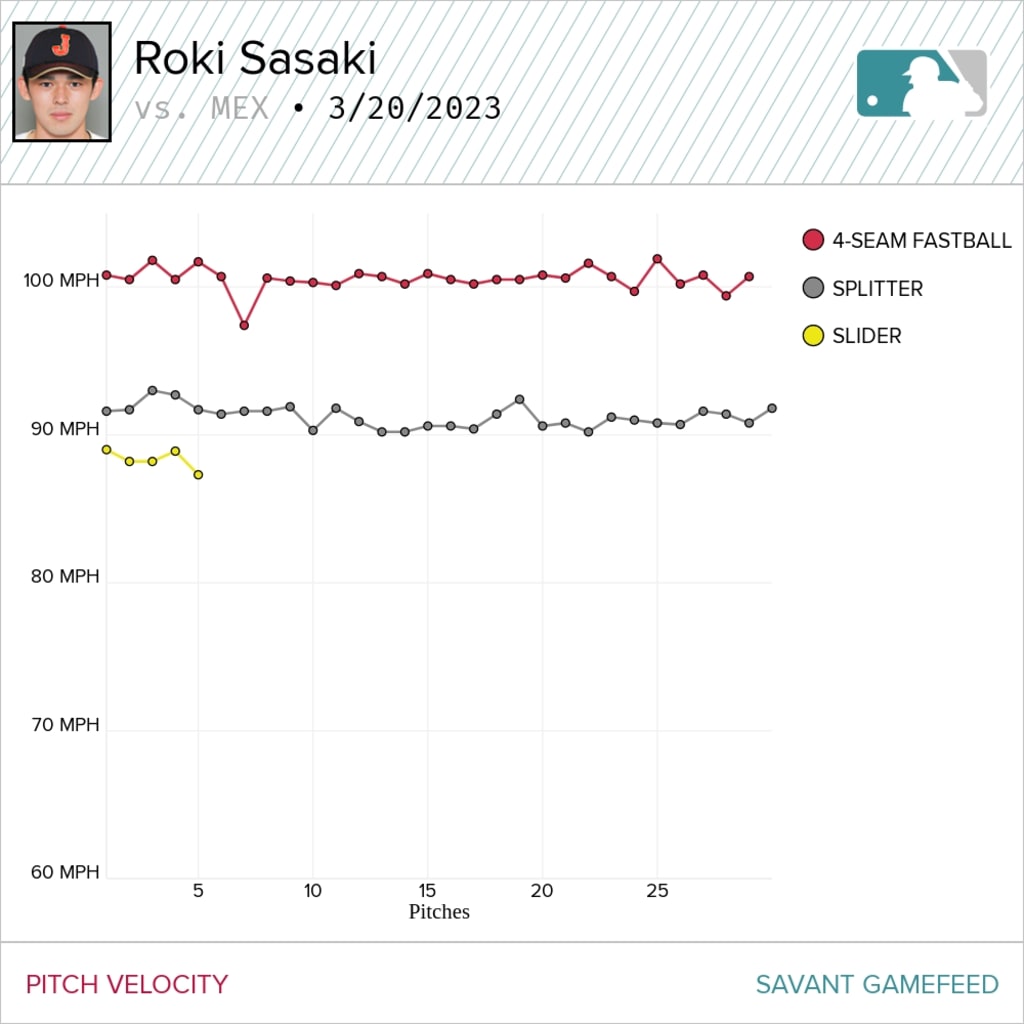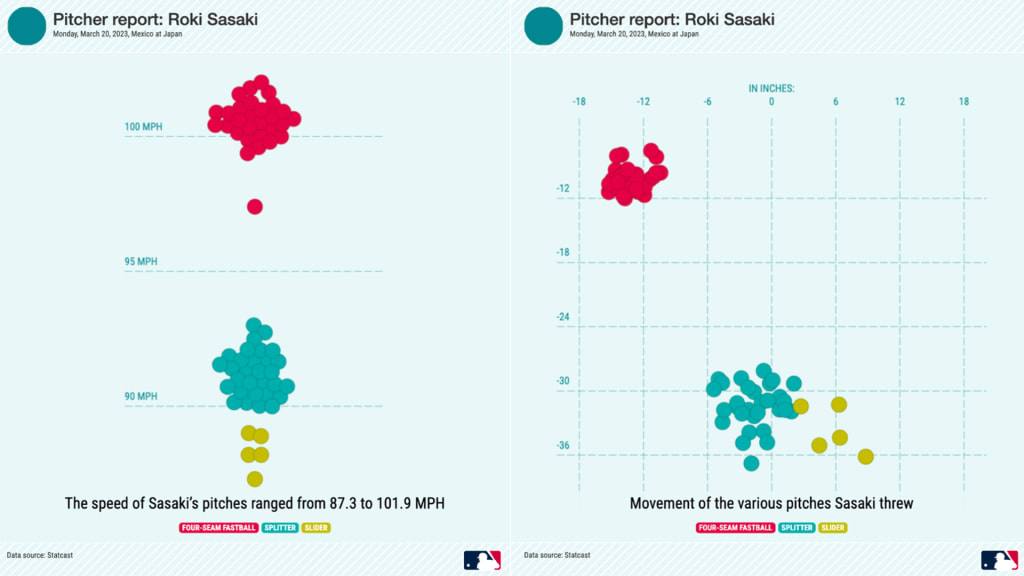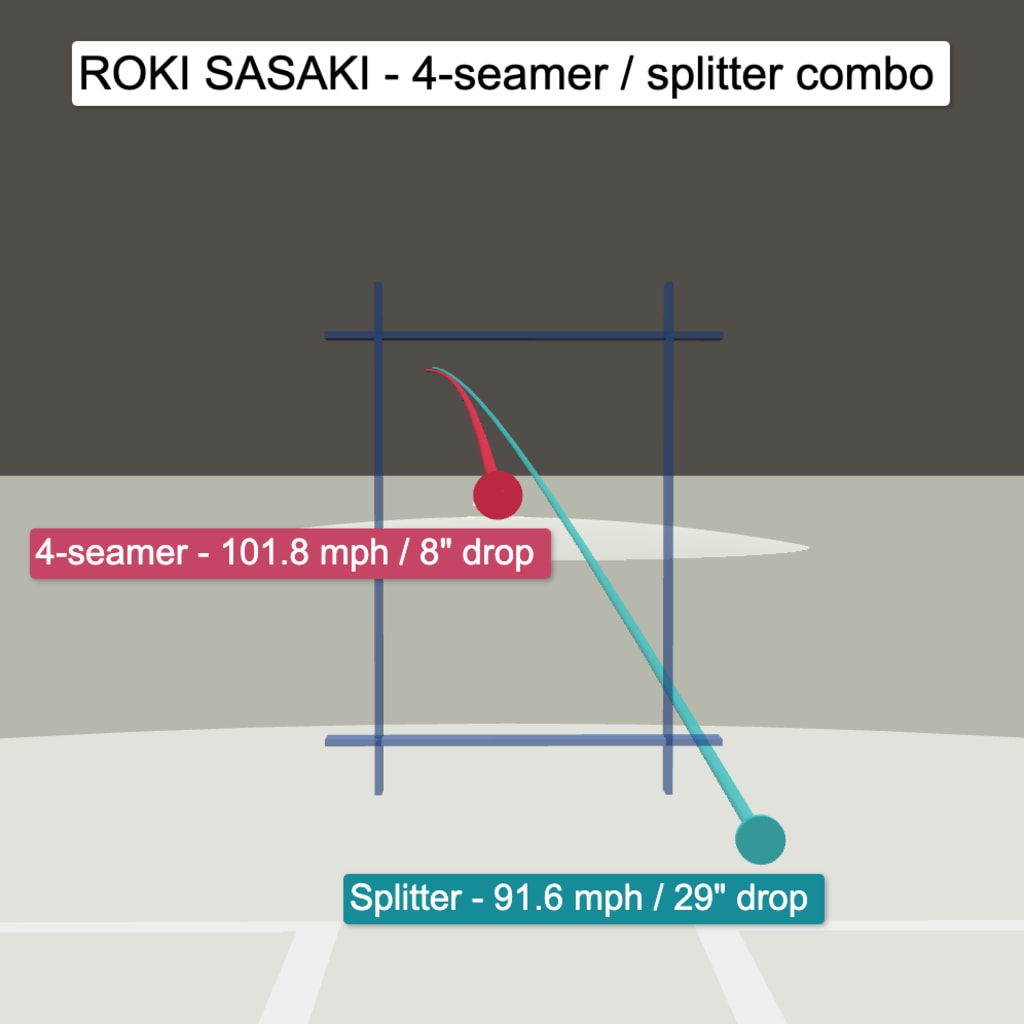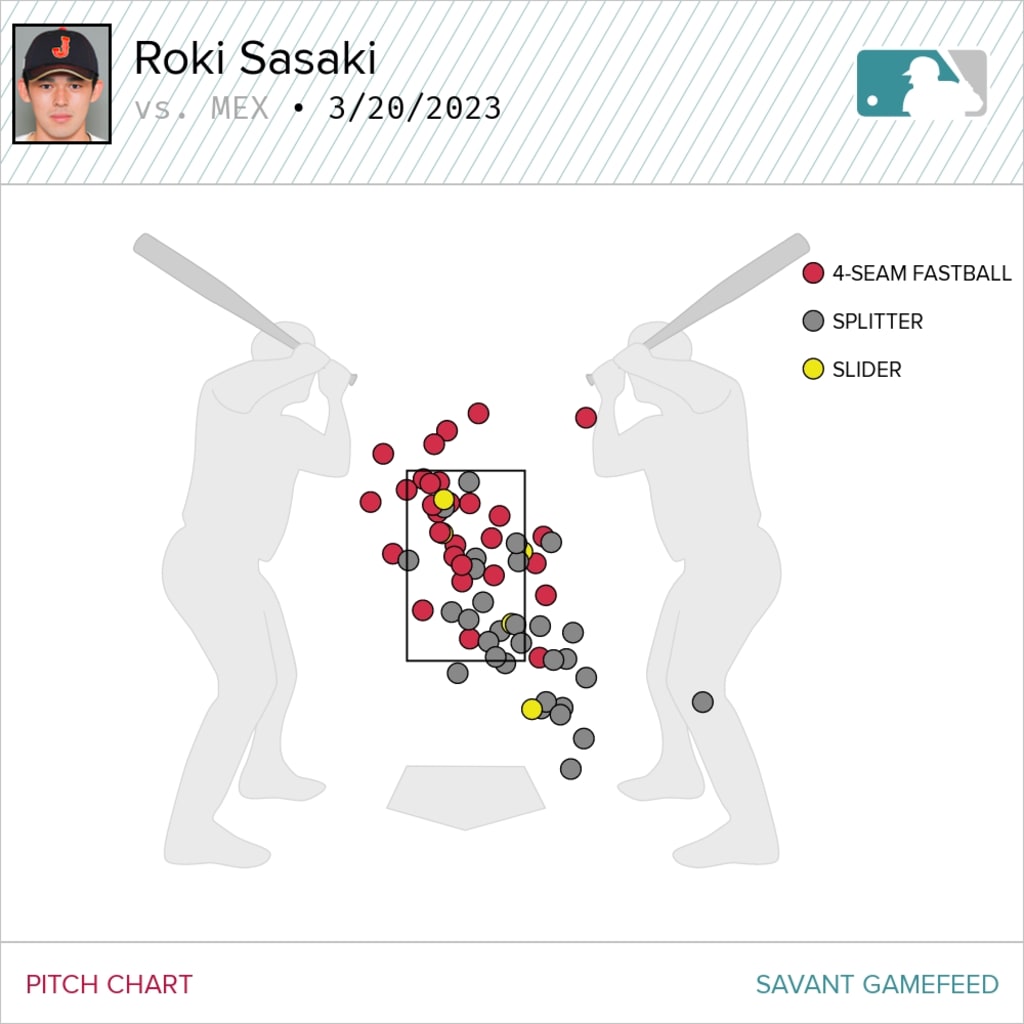When the World Baseball Classic started, we knew what Roki Sasaki was already doing in Japan. We knew the 21-year-old might be one of the nastiest pitchers in the world.
Now we have proof.
Sasaki's phenomenal talent was on display in his WBC semifinal start against Mexico. And since he was finally pitching in an MLB ballpark, in front of Hawk-Eye tracking technology, we got a full range of Statcast data on Sasaki for the first time.
We know how hard he throws. We know how much movement his pitches have. We know how he uses his fastball/splitter combo. And, spoiler: It's all ridiculous.
Let's break down Sasaki's electric stuff.
THE FASTBALL
Sasaki's average fastball velocity in the WBC semfinals: 100.5 mph. His max velo: 101.9 mph. In the first inning, he blew away Mexico's best hitter, Randy Arozarena, at 101.8 mph.
Sasaki threw 29 fastballs in total. Twenty-six of them were 100 mph or faster.
Just ... look at his list of velocity readings:
100.8 mph, 100.5 mph, 101.8 mph, 100.5 mph, 101.7 mph, 100.7 mph, 97.4 mph, 100.6 mph, 100.4 mph, 100.3 mph, 100.1 mph, 100.9 mph, 100.7 mph, 100.2 mph, 100.9 mph, 100.5 mph, 100.2 mph, 100.5 mph, 100.5 mph, 100.8 mph, 100.6 mph, 101.6 mph, 100.7 mph, 99.7 mph, 101.9 mph, 100.2 mph, 100.8 mph, 99.4 mph, 100.7 mph

That's elite-elite, even if you compare Sasaki to the hardest-throwing Major League starters.
Insane. Here's the list of MLB starting pitchers who've hit triple-digit velocity as many times in a game in the entire pitch-tracking era, which goes back to 2008:
• Hunter Greene (six times)
• Jacob deGrom (twice)
• Nathan Eovaldi (once)
• Yordano Ventura (once)
That's it. Sasaki is just the fifth pitcher on record with 26 fastballs clocked at 100-plus mph in a single game.
Then there's the fact that 90% of the fastballs Sasaki threw were 100 mph or faster. That is the highest rate of triple-digit fastballs out of every single starting pitcher who's ever thrown at least 25 fastballs in a game under modern pitch tracking.
Highest % of 100+ mph fastballs in a start, pitch-tracking era
Min. 25 fastballs thrown in the game
- Roki Sasaki (Japan): 90% -- 2023 WBC semifinals
- Jordan Hicks (Cardinals): 89% -- July 12, 2022
- Hunter Greene (Reds): 86% -- Sept. 17, 2022
- Jacob deGrom (Mets): 75% -- June 5, 2021
- Hunter Greene (Reds): 69% -- July 26, 2022
Now here's why Sasaki's four-seamer is explosive beyond just its velocity: It also has a rare combination of rise and run.
On average, Sasaki's fastball dropped just 10.1 inches on its way to the plate. Only three MLB pitchers averaged less drop than that on their four-seamers in 2022: Félix Bautista, Ryan Helsley and James Karinchak -- all shutdown relievers with great rising fastballs. (And when it comes to fastballs, "more rise" is really "less drop" … a "rising fastball" can't literally rise; it just looks that way to the hitter.)
But while the four-seamers those power pitchers throw often stay true -- coming straight at the hitter -- Sasaki's picks up a lot of arm-side run on its way to the batter.
His fastball averaged 13.1 inches of run in the WBC semifinals and got as much as 15 inches of run.

Only a few MLB pitchers have a fastball with all the characteristics of Sasaki's. The big one: Gerrit Cole. The Yankees ace averaged 97.8 mph on his four-seamer last season with 10.5 inches of drop and 10.4 inches of run. He has one of the best fastballs in baseball. Sasaki's has the profile to rival Cole's.
THE SPLITTER
But enough about Sasaki's 102 mph fastball. Let's get to his best pitch.
Yes, his best pitch is not the triple-digit heater. It is his drop-off-the-table splitter.
Sasaki's splitter looked incredible against Mexico. It has true high-end velocity, coming in at well over 90 mph, and sharp vertical movement, dropping over 30 inches.
Sasaki's average splitter velocity in the game was 91.2 mph. He reached as high as 93.0 mph. His splitter is like Jacob deGrom's slider -- a secondary pitch that's as hard as a lot of Major League pitchers' fastballs.
Meanwhile, its average vertical break was 31.4 inches. It dropped as much as 37 inches … over three feet.
And when we say "drop-off-the-table," we mean it. Sasaki's splitter plummets straight down, barely moving horizontally at all (1.6 inches on average vs. Mexico). It's very difficult for batters to keep their swing on plane with it and make contact.

Sasaki generated a 53% whiff rate with his splitter in the WBC semifinals. In other words, Mexico's hitters whiffed on over half their swings against it (nine of 17). That is an elite swing-and-miss number for any pitch type.
There were really only two Major League pitchers last season who threw a splitter like Sasaki's -- a high-velocity "offspeed" pitch with strong, straight-downward break.
One was Aroldis Chapman (88.1 mph, 36.1 inches of drop, 2.1 inches of horizontal movement). The other was Shohei Ohtani (89.3 mph, 32 inches of drop, 5.5 inches of horizontal movement).
That pitch profile makes Sasaki's fastball/splitter combo devastating. It has to be near-impossible for a hitter to identify a Sasaki splitter and react before it's too late.
And look at how he locates the two pitches, with his splitters coming right across the zone in his fastballs' shadow before they drop down onto the corner, or into the chase region just out of the strike zone.

You should also notice from that pitch chart that Sasaki attacks the hitter with all of his pitches. He threw his fastball in the strike zone 62% of the time against Mexico. He threw his splitter in the zone 57% of the time. That in particular is a strong contrast from dominant splitter pitchers like Ohtani, who threw his split-finger out of the zone 71% of the time last season.
For Ohtani, the splitter is primarily a chase pitch to get a strikeout. For Sasaki, it can be a go-to pitch in any situation, a point also reflected by his overall splitter usage of 47% against Mexico's lineup, which made it his most-thrown pitch in the game. Sasaki and Ohtani share a dominant fastball/splitter combo, but Sasaki is also overpowering in his own way.
Watching Sasaki live at the Classic would be enough to make any MLB fan want him here, now, pitching for their team. Seeing the Statcast numbers behind his electric stuff only makes it harder to wait.
